Pet Insurance Review > Pet Wellness Guides > Bloat in Dogs: Is Your Dog at Risk? - Pet Insurance Review
Bloat in Dogs: Is Your Dog at Risk?
Posted: 11/06/2023 | BY: Erin Cain | Categories: Uncategorized
Bloat in dogs is a hazardous medical condition that occurs when the stomach twists and bloats. Air or gas becomes trapped in the dog’s abdomen. It can resolve itself, but the dog will need immediate emergency surgery if it progresses into gastric dilatation-volvulus (GDV). Dogs of all ages can develop bloat, but middle-aged dogs seem most prone. A study from Purdue University found that risk increased by 20% for each year of a dog’s life.
All pup parents should be aware of a dog’s risk factors:
- A large, deep chest
- A breed at high risk for bloat
- Eating too fast or gulping air, and drinking lots of water or other fluids before or after eating
If your dog falls into one of these bloat risk categories, then it could mean she may contend with bloat at some point in her life. Read on to find out more about bloat in dogs and what you can do to prevent it.
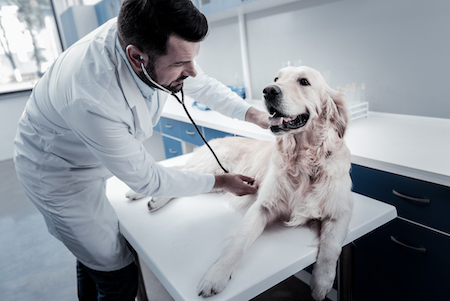
What is bloat (Gastric Dilatation-Volvulus)?
Gastric dilatation-volvulus (GDV), or bloat, is a severe condition and can be fatal if left untreated. Bloat occurs when the dog’s stomach fills with gas, food, or fluid, then twists and flips, resulting in severe pain for your pet and death if not addressed immediately. When gas, liquid, or food build up in the dog’s intestines, it affects the blood flow to and around the stomach and puts pressure on surrounding organs. This pressure decreases blood supply throughout the body until there is no longer any oxygen available.
Bloat is always an emergency; the longer it takes to get treatment for a dog with bloat, the more likely she will die.
What are the symptoms of bloat in dogs?
Note that not all dogs with bloat will exhibit the same signs. Some of the most common symptoms can be difficult for pup parents to notice in their pet’s posture or behavior. Most dogs experiencing bloat do show at least one of the following signs of the condition:
Restlessness and pacing
Dogs can experience a lot of pain when they are affected by bloat. They will have trouble getting comfortable and lying down because their bodies are in genuine physiological distress. In many canines with bloat, pacing and restlessness are the earliest signs of GDV.
Bloated, distended abdomen
The location of a dog’s abdomen can change depending on the breed and size. If your pup is a giant breed or has a deep chest, her stomach might be located behind the rib cage instead of in the traditional belly area. That location is often difficult for a dog owner to find and feel a bloated stomach. If your dog has a thick coat or is overweight, it may be even more challenging to see her twisted stomach or swollen stomach. Even if you find the stomach and don’t feel any pronounced extension, your dog may still be in the beginning stages of the condition.
Retching and dry heaving
If a dog suffers from bloat, she may vomit and dry heave without anything coming out. You might notice small amounts of water or stringy, thick saliva expelled from her mouth. This type of unproductive retching is an emergency sign of bloat in your dog.
Heavy, fast, difficult breathing
Bloat causes your dog to have reduced space in their chest for the lungs. Still, it also affects acidity levels as well as other metabolic functions. The distress, anxiety, and pain associated with bloat also lead to breathing changes and difficulties.
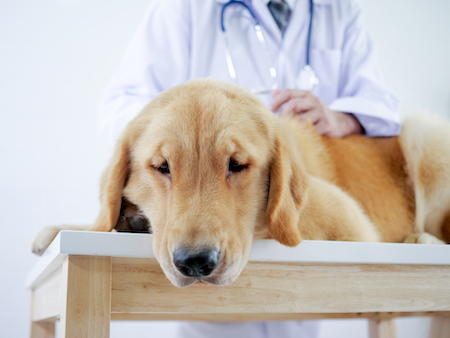
Rapid pulse and heart rate
GDV can cause your dog’s heart rate and pulse to quicken, which is an early sign of distress. This accelerated heartbeat will likely worsen as the condition progresses due primarily to the body not getting enough blood flow to function properly. This sign indicates a dog in a state of shock.
Falling and collapse
It is essential to know that collapse typically occurs later than other signs of GDV. When an affected dog begins collapsing, their condition has often become advanced and dire. At this point, it would be unlikely that they would survive without emergency treatment.
What causes bloat?
Despite the extensive research for a specific cause of bloat, no particular reason has been found. Veterinarians note that bloat in dogs is often linked to the following risk factors:
- increased age
- exercise after eating
- genetic predisposition
- raised food bowls
- eating overly quickly
- drinking large amounts of water in short periods
- overeating
- stress and anxiety
Any dog can be susceptible to bloat; however, this condition occurs in some breeds more than others.
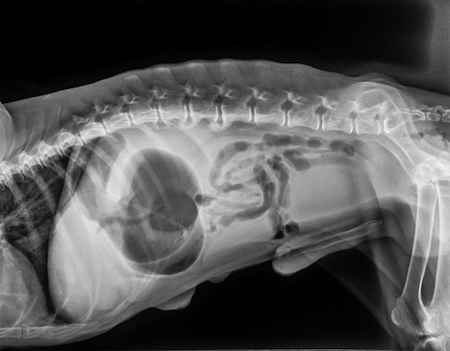
Which dog breeds are at increased risk for bloat?
The most predisposed breeds for bloat are large breed dogs, giant breed dogs, and deep-chested breeds. Deep-chested dogs also have a higher chance of experiencing this emergency condition. Here are the high-risk breeds more prone to experiencing bloat:
- Great Danes
- St. Bernard
- Weimaraner
- German Shepherd
- Old English Sheepdog
- Doberman Pinscher
- Standard Poodle
- Golden Retriever
- Labrador Retriever
- Irish Wolfhound
- Basset Hounds
- Newfoundland
- Bernese Mountain Dog
- Akita
- Greyhound
- Boxer
- Bull Mastiff
- Chow Chow
- Collie
Dogs who weigh over 100 pounds or small breed canines of advanced age are also in a high-risk category for developing GDV.
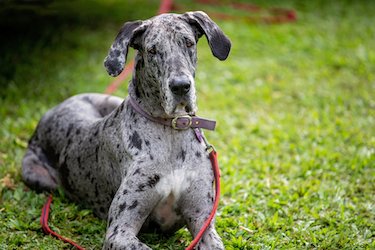
How Is Bloat Treated?
Bloat cannot be treated at home, and there are no home remedies to fix this medical problem. A dog suffering from this life-threatening condition must be seen by a veterinarian as quickly as possible. GDV can kill a dog within an hour, so the first step for treatment is at the emergency clinic.
A veterinarian will examine your dog and her symptoms, then run diagnostic tests. Then, a GDV diagnosis is confirmed through abdominal radiography. An EKG is used to detect any abnormal heartbeats caused by bloat. Stabilization and non-surgical treatment is then employed for dogs who have bloat without GDV, usually through pain medications and intravenous fluids. However, those dogs who have bloat and GDV will need GDV surgery.
The dog’s stomach is untwisted during this procedure and then returned to its original position. In extreme cases, veterinary surgeons will perform a gastropexy, where the stomach is permanently attached to the abdominal wall. Studies show that this surgery has a 90-95% success rate. Research also found that 80% of dogs with GDV survive with prompt treatment.
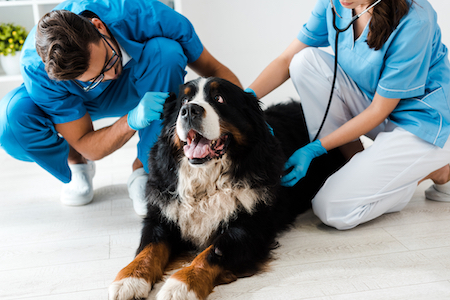
Can you prevent bloat?
There are simple steps to take to prevent GDV in your dog. Current recommendations include:
- avoid strenuous exercise after meals
- feed multiple smaller meals throughout the day, rather than one large meal
- don’t let your dog drink excessive amounts of water at one time
- avoid using a raised food bowl
- reduce canine stress or anxiety
- train your dog to eat slowly
- avoid feeding wet food that includes citric acid as an ingredient
- select an appropriate dry food with your veterinarian’s advice
- speak with your veterinarian if you suspect bloat
An Increasingly popular prevention is the gastropexy procedure. For dogs prone to developing bloat, having this surgery before the condition occurs helps prevent 95% of GDV.
Get extra protection for your furkid.
You love your dog, and it’s easy to worry about her health and wellbeing. Let Pet Insurance Review find a dog health insurance policy that will be there if your dog suffers from GDV or another life-threatening disorder. Animal emergency clinics come with high vet costs, and you’ll have enough to worry about when your dog is in the vet’s hands. Get a free pet insurance quote and have one less concern when you need to focus on your dog’s health.
References:
1. Bell, J. (2003). Risk Factors for Canine Bloat. Retrieved from https://www.vin.com/apputil/content/defaultadv1.aspx?pId=11165&meta=Generic&id=3848657
2. Nicholas, J. (2021). Is My Dog at Risk for Canine Bloat, Torsion, and GDV? Retrieved from https://www.preventivevet.com/dogs/is-my-dog-at-risk-for-canine-bloat-torsion-and-gdv
3. AKC Canine Health Foundation. (2021). Understanding Gastric Dilatation-Volvulus,or “Bloat.” Retrieved from https://www.akcchf.org/canine-health/top-health-concerns/bloat/understanding-bloat.html
4. BluePearl Specialists. (2022). Gastric Dilatation-Volvulus (Stomach Bloat or GDV) in Dogs. Retrieved from https://bluepearlvet.com/medical-articles-for-pet-owners/stomach-bloat-in-dogs/
5. Johnson, M. (2011). Bloat: Preventing a deadly dog illness. Retrieved from http://www.cnn.com/2011/LIVING/04/23/bloat.dog.illness.mnn/index.html
6. Ward, M., Patronek, G., Glickman, L. (2003). Benefits of prophylactic gastropexy for dogs at risk of gastric dilatation-volvulus. Retrieved from https://www.sciencedirect.com/science/article/abs/pii/S0167587703001429?via%3Dihub
Disclaimer
The information contained on this blog is intended for informational and educational purposes only and should not be construed as medical advice. It is not a substitute for professional veterinary care. Always consult with your veterinarian before making any changes to your pet's health care or treatment plan.
The authors of this blog are not veterinarians and do not claim to be experts in pet health. The information provided here is based on our own experiences and research, as well as information from reputable sources. However, we cannot guarantee the accuracy or completeness of this information.
We encourage you to do your own research and consult with your veterinarian before making any decisions about your pet's health.